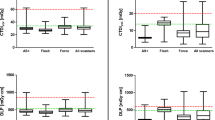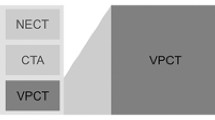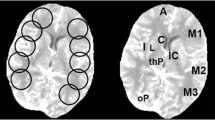Abstract
Objectives
The aim was to measure the effective dose of flat-detector CT (FDCT) whole-brain imaging, biphasic FDCT angiography (FDCT-A), and FDCT perfusion (FDCT-P) protocols and compare it to previously reported effective dose values of multidetector CT (MDCT) applications.
Materials
We measured effective dose according to the IRCP 103 using an anthropomorphic phantom equipped with thermoluminescent dosimeters (TLDs). Placement was according to anatomical positions of each organ. In total, 60 TLDs (≥ 4 TLDs/organ) were placed into and onto the phantom to account for all relevant organs. Organs within the primary beam were covered with more TLDs. Additionally, we measured dose to the eye lens with two TLDs per eye. Protocols which we routinely use in clinical practice were measured on a biplane angiography system.
Results
The effective dose of the 20-s protocol/7-s protocol for whole-brain imaging was 2.6 mSv/2.4 mSv. The radiation dose to the eye lens was 24/23 mGy. For the biphasic high-/low-dose FDCT-A protocol, the effective dose was 8.9/2.8 mSv respectively. The eye lens dose was 60/14 mGy. The contribution of bolus tracking to the effective dose was 0.66 mSv (assuming average duration of 14 s). The multisweep FDCT-P protocol had an effective dose of 5.9 mSv and an eye lens dose of 46 mGy.
Conclusion
Except for the high-dose biphasic FDCT-A protocol, FDCT applications used in neuroradiology have effective doses, which do not deviate more than 1 mSv from previously reported values for MDCT applications. However, the effective dose to the eye lens in commonly used stroke paradigms exceeds the recommended annual dose twofold.
Key Points
• Flat-detector computed tomography (FDCT) can be used for acute and periinterventional imaging of acute stroke patients and in neurointerventions.
• Except for the high-dose FDCT angiography protocol, the effective doses do not deviate more than 1 mSv from previously reported values for multidetector CT applications.
• Strategies to decrease the effective lens dose especially in younger patients should be evaluated in the future.


Similar content being viewed by others
Abbreviations
- FDCT:
-
Flatpanel-detector CT
- FDCT-A:
-
FDCT angiography
- FDCT-P:
-
FDCT perfusion
- MDCT:
-
Multidetector CT
- TLD:
-
Thermoluminescent dosimeter
References
Psychogios MN, Behme D, Schregel K et al (2017) One-stop management of acute stroke patients: minimizing door-to-reperfusion times. Stroke 48:3152–3155
Hoelter P, Goelitz P, Lang S et al (2019) Visualization of large vessel occlusion, clot extent, and collateral supply using volume perfusion flat detector computed tomography in acute stroke patients. Acta Radiol 60(11):1504–1511
Brehm A, Tsogkas I, Maier IL et al (2019) One-stop management with perfusion for transfer patients with stroke due to a large-vessel occlusion: feasibility and effects on in-hospital times. AJNR Am J Neuroradiol 40(8):1330–1334
Leyhe JR, Tsogkas I, Hesse AC et al (2017) Latest generation of flat detector CT as a peri-interventional diagnostic tool : a comparative study with multidetector CT. J Neurointerv Surg 9(12):1253–1257. https://doi.org/10.1136/neurintsurg-2016-012866
Lian Y, Xiao J, Ji X et al (2015) Protracted low-dose radiation exposure and cataract in a cohort of Chinese industry radiographers. Occup Environ Med 72(9):640–647
Elmaraezy A, Morra ME, Mohammed AT et al (2019) Risk of cataract among interventional cardiologists and catheterization lab staff : a systematic review. Catheter Cardiovasc Interv 90(1):1–9
Internationalen Strahlenschutzkommission (2007) Veröffentlichungen der Internationalen Strahlenschutzkommission Deutsche Ausgabe herausgegeben vom Bundesamt für Strahlenschutz
Yang P, Niu K, Wu Y et al (2017) Evaluation of collaterals and clot burden using time-resolved C-arm conebeam CT angiography in the angiography suite: a feasibility study. AJNR Am J Neuroradiol 38(4):747–752
Maier XIL, Leyhe XJR, Tsogkas XI et al (2018) Diagnosing early ischemic changes with the latest-generation flat detector CT: a comparative study with multidetector CT. AJNR Am J Neuroradiol 39(5):881–886
Struffert T, Hauer M, Banckwitz R, Köhler C, Royalty K, Doerfler A (2014) Effective dose to patient measurements in flat-detector and multislice computed tomography: a comparison of applications in neuroradiology. Eur Radiol 24(6):1257–1265
Lin HC, Lai TJ, Tseng HC, Wang CH, Tseng YL, Chen CY (2019) Radiation doses with various body weights of phantoms in brain 128-slice MDCT examination. J Radiat Res 60(4):466–475
Fiorella D, Turk A, Chaudry I et al (2014) A prospective, multicenter pilot study investigating the utility of flat detector derived parenchymal blood volume maps to estimate cerebral blood volume in stroke patients. J Neurointerv Surg 6(6):451–456
Yang P, Niu K, Wu Y et al (2015) New capability for one-stop-shop acute ischemic. Stroke 46(12):3383–3389
Psychogios M, Schramm P, Frölich AM et al (2013) Alberta stroke program early CT scale evaluation of multimodal computed tomography in predicting clinical outcomes of stroke patients treated with aspiration thrombectomy. Stroke 44(8):2188–2193
Psychogios M-N, Schramm P, Buhk J et al (2010) Angiographic CT after intravenous contrast agent application: a noninvasive follow-up tool after intracranial angioplasty and stenting. AJNR Am J Neuroradiol 31(10):1886–1891
Schregel K, Tsogkas I, Peter C et al (2018) Outcome prediction using perfusion parameters and collateral scores of multi-phase and single-phase CT angiography in acute stroke: need for one, two, three, or thirty scans? J Stroke 20(3):362–372
Ainsbury EA, Barnard S, Bright S et al (2016) Ionizing radiation induced cataracts: recent biological and mechanistic developments and perspectives for future research. Mutat Res 770(Pt B):238–261
Dauer LT, Ainsbury EA, Dynlacht J et al (2017) Guidance on radiation dose limits for the lens of the eye: overview of the recommendations in NCRP Commentary No. 26. Int J Radiat Biol 93(10):1015–1023
Bolch WE, Dietze G, Petoussi-henss N, Zankl M (2015) Dosimetric models of the eye and lens of the eye and their use in assessing dose coefficients for ocular exposures. Ann ICRP 44(1 Suppl):91–111
Fahrig R, Dixon R, Payne T, Morin RL, Ganguly A, Strobel N (2006) Dose and image quality for a cone-beam C-arm CT system. Med Phys 33(12):4541–4550
Kalender WA, Kyriakou Y (2007) Flat-detector computed tomography (FD-CT). Eur Radiol 17(11):2767–2779
Funding
No funding was received for this specific study.
Author information
Authors and Affiliations
Corresponding author
Ethics declarations
Guarantor
The scientific guarantor of this publication is Marios-Nikos Psychogios.
Conflict of interest
Grant: Siemens. Comments: research grant with the Department of Neuroradiology (University Medical Center Göttingen); money paid to the institution
Statistics and biometry
No complex statistical methods were necessary for this paper.
Informed consent
No informed consent was necessary, because no patients or probands have been included in this study.
Ethical approval
Institutional Review Board approval was not required because it was a phantom study, not including any patients or animals.
Methodology
• experimental
• performed at one institution
Additional information
Publisher’s note
Springer Nature remains neutral with regard to jurisdictional claims in published maps and institutional affiliations.
Rights and permissions
About this article
Cite this article
Brehm, A., Stamm, G., Lüpke, M. et al. Effective dose to patient measurements for flat-detector computed tomography protocols in acute stroke care. Eur Radiol 30, 5082–5088 (2020). https://doi.org/10.1007/s00330-020-06891-w
Received:
Revised:
Accepted:
Published:
Issue Date:
DOI: https://doi.org/10.1007/s00330-020-06891-w




